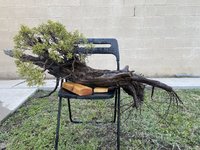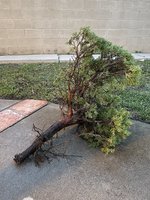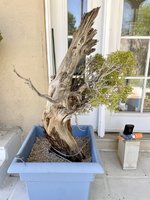walee
Yamadori
About a week ago, I went on my first Juniper Yamadori collecting trip and brought home two fine specimens which I'm praying to the gods, will survive. This was an extremely fun and memorable experience for me, but I feel no amount of reading would have probably fully prepared me for what I was going to face in the field, and thus, I have returned with quite a few questions for the community.
Both trees were extremely hard to dig though. I first tried digging a trench around the canopy and cutting any roots larger than 1". I then gently moved radially inward poking the dirt with a screw driver to loosen the soil around the roots. This proved difficult because I kept running into large chunks of rocks which would tear off clusters of tender roots as they were plucked off. My god, there are no words to express the dread that you feel rush down your body when you head that faithful root snap when you tug the tree around. All in all, I think my lesson learned is to try and take as much dirt near the base of the tree, as I possibly can, and just worry later about the archeological endeavor that it is to gently removing soil without destroying roots.
All in all, I think my lesson learned is to try and take as much dirt near the base of the tree, as I possibly can, and just worry later about the archeological endeavor that it is to gently removing soil without destroying roots.
Is there any advise from the community on how to best dig out the trees without completely obliterating the fine roots? Whats the best method to dig under the rootball and lift the tree out without large chunks of soil crumbling off and taking roots with it!
Anyways, if you've made it this far, I appreciate your time, and here are a couple photos of trees I chose:
- The first tree had an absolutely MASSIVE trunk and was relatively loose, so I thought that would make for an easy harvest (not really).
- The second tree had a really nice thick 2-3" trunk, a relatively short compact canopy for its size, and was growing berries which really attracted me to it (but I now realize berries may be a sign of stress on the tree ).
).
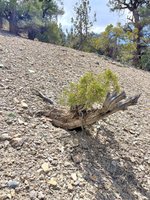
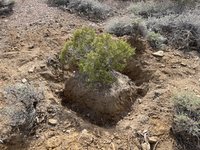
I would also like to send a shoutout to @PaulH, who was very helpful when I reach out to him. Ty
Both trees were extremely hard to dig though. I first tried digging a trench around the canopy and cutting any roots larger than 1". I then gently moved radially inward poking the dirt with a screw driver to loosen the soil around the roots. This proved difficult because I kept running into large chunks of rocks which would tear off clusters of tender roots as they were plucked off. My god, there are no words to express the dread that you feel rush down your body when you head that faithful root snap when you tug the tree around.
Is there any advise from the community on how to best dig out the trees without completely obliterating the fine roots? Whats the best method to dig under the rootball and lift the tree out without large chunks of soil crumbling off and taking roots with it!
Anyways, if you've made it this far, I appreciate your time, and here are a couple photos of trees I chose:
- The first tree had an absolutely MASSIVE trunk and was relatively loose, so I thought that would make for an easy harvest (not really).
- The second tree had a really nice thick 2-3" trunk, a relatively short compact canopy for its size, and was growing berries which really attracted me to it (but I now realize berries may be a sign of stress on the tree


I would also like to send a shoutout to @PaulH, who was very helpful when I reach out to him. Ty

